- eISSN 2353-8414
- Tel.: +48 22 846 00 11 wew. 249
- E-mail: minib@ilot.lukasiewicz.gov.pl
Inteligencja emocjonalna w marketingu: badanie umiejętności osobistych I społecznych oraz ich wpływu na skuteczność marketingu
Liza Mousli1*, Chafika Larras2, Mehdi Bouchetara3, Sabrina Iraten4
1Independent Researcher, Tizi-Ouzou, 15000, Algeria
2–4Higher School of Management, Kolea, 42003 Tipaza, Algeria
1*E-mail: Mousliliza@gmail.com
ORCID: 0009-0001-2408-4988
2E-mail: C.larras@ensmanagement.edu.dz
ORCID: 0000-0002-5755-9636
3E-mail: M.bouchetara@ensmanagement.edu.dz
ORCID: 0000-0001-9826-8985
4E-mail: S.iraten@ensmanagement.edu.dz
ORCID: 0000-0002-0183-5769
DOI: 10.2478/minib-2023-0026
Abstrakt:
Badanie to analizuje znaczenie inteligencji emocjonalnej (EI) w marketingu wśród specjalistów z branży telekomunikacyjnej w Algierii. Inteligencja emocjonalna odgrywa kluczową rolę w budowaniu silnych relacji, efektywnej komunikacji i tworzeniu połączeń, zwłaszcza wraz z postępem technologii i sztucznej inteligencji. Jednak istnieją ograniczone badania dotyczące inteligencji emocjonalnej u specjalistów marketingu w branży telekomunikacyjnej. Wykorzystując ilościowe badania ankietowe i analizę regresji, badanie wykazuje pozytywny wpływ wymiarów inteligencji emocjonalnej na efektywność marketingu. Te wyniki mają implikacje dla poprawy wydajności zespołów marketingowych poprzez wdrożenie programów szkoleniowych zwiększających umiejętności inteligencji emocjonalnej. Badanie przyczynia się do społeczności naukowej, podkreślając znaczenie inteligencji emocjonalnej w marketingu i zachęcając do dalszych badań.
MINIB, 2023, Vol. 50, Issue 4
DOI: 10.2478/minib-2023-0026
Str. 137-164
Opublikowano 13 grudnia 2023

Inteligencja emocjonalna w marketingu: badanie umiejętności osobistych I społecznych oraz ich wpływu na skuteczność marketingu
Introduction
Emotional intelligence (EI), which refers to a person’s innate ability to recognise, manage, comprehend, and control emotions and emotional data (Singh et al., 2022), plays a crucial role in navigating and responding to emotional states effectively. Possessing a range of cognitive abilities and skills in this regard enhances social relationships and overall emotional well-being.
Furthermore, the importance of EI transcends interpersonal relationships and affects the workplace. Scientific literature widely recognises the substantial impact of EI on professional performance and organisational outcomes (Bansal et al., 2022; Hussain, 2021; Khraim, 2023). In fact, recent studies have even highlighted EI as a highly reliable predictor of organisational success (Pradeep, 2022; Supramaniam & Singaravelloo, 2019). Consequently, fields such as organisational psychology have begun giving considerable attention to the influence of EI on various aspects of work life (Schlegel & Mortillaro, 2019).
In the midst of advancements in information technology and artificial intelligence, the landscape of professional activities is poised for a significant transformation (Lavraè et al., 2023). Interestingly, the increasing dominance of artificial intelligence can be attributed, at least in part, to the growing interest in EI. Tasks that require intuitive and empathetic intelligence, closely related to EI, pose challenges for AI programs to accomplish (Huang & Rust, 2018). Recognising the importance of fostering and showcasing our human traits becomes essential as automation takes over mechanical and analytical work conducted by robots and algorithms.
Nowhere is the significance of EI more apparent than in professions such as marketing and sales, where success is strongly dependent on good interpersonal relationships, open communication, and the capacity for connection. Since it is directly related to these factors, EI assumes a crucial role in this industry. Extensive research has investigated the function of EI in sales, with some studies finding a positive correlation between high levels of EI and successful sales performance (Anees et al., 2020; Pegah, 2020).
Despite the considerable body of research in various industries, including media, furniture, automotive, and finance, there remains a noticeable gap in studies explicitly targeting marketing executives in the service sector. This gap is particularly evident in the telecom industry, where the relationship between EI and sales success has received limited attention.
To address this gap and maximise the contributions of marketing specialists to their sector, it is crucial to examine how EI is utilised by professionals in this booming industry. Such research can offer valuable insights to managers, recruiters, and business owners in identifying and nurturing top marketing talent while also empowering marketers to identify areas for improvement, ultimately enhancing their marketing effectiveness.
This research project adopts a post-positivist epistemological stance and a hypothetically deductive approach. A quantitative study that relied on documentary research and a questionnaire survey was carried out in order to address the research topic and assess the hypotheses.
A sample of Algerian marketers specialising in the telecommunications industry constituted the subject of the survey. A stratified sampling technique was used to create a representative sample of this population, considering the company and gender.
This study’s goal was to collect information from a sample of 141 employees who were approached and given an invitation to participate. A response rate of roughly 65.25% was achieved with 92 participants out of the total number of people contacted. The following is how the study’s research question is stated: 'To which extent does the perception, comprehension, management, and utilisation of emotions-the four components of EI-affect marketing effectiveness?’ The four aspects of EI that are the focus of the current study are selfawareness, self-management, social awareness, and relationship management. According to the premise, having stronger EI in these four areas results in more effective marketing as assessed by key performance indicators. The following hypotheses have been generated based on previous study on the topic (Bhalerao & Sharma, 2017; Halim, 2021; Nwokah & Ahiauzu, 2009):
1. H1: Strong self-awareness enables marketers to more successfully target their audience based on their emotional needs and recognise their own emotional influence on others, which has a huge impact on marketing performance.
2. H2: The ability to successfully manage difficult situations, make wise decisions, and work more efficiently are all benefits of self-management.
3. H3: By enabling marketers to comprehend consumer expectations and motives, produce more pertinent advertising messages, and adjust to market developments, social awareness has a substantial impact on marketing performance.
4. H4: Emotion utilisation helps marketers build trusting connections with customers and gain a deeper understanding of their requirements and motivations, which has a substantial impact on marketing effectiveness.
Literature Review
EI
The idea of EI has come into focus recently as a potential factor to account for behavioural variation. Numerous scholars have expressed interest in the idea of EI, and as this field of study has developed, so too has our understanding of the idea. Three viewpoints on EI models can be distinguished: ability models, trait models, and mixed models. The capacity models emphasise cognitive and perceptual abilities connected to understanding and controlling emotions, treating EI as a pure mental capacity. A constellation of self-perceptions of emotions located at lower levels of personality hierarchies is how trait EI is defined by trait models. To improve leadership effectiveness, mixed models, such as Goleman’s model, combine personality traits with emotional abilities (Dhani & Sharma, 2016; Kanesan & Fauzan, 2019; Singh et al., 2022).
The four major branches of emotion-related abilities are described in this framework, which operates at various levels of complexity, from lowlevel information processing to the strategic and intentional utilisation of emotional information to achieve personal goals. These four areas of study are (a) accurate emotional perception, (b) using emotions to help with decision-making, (c) understanding emotions, and (d) managing emotions to balance positive and negative emotions. (Singh et al., 2022).
Marketing effectiveness
Highly valuable organisational outcomes including long-term growth, stability, client satisfaction, competitive advantage, and a strong marketing focus are directly correlated with marketing effectiveness (Webster, 1995).
According to Kayabasi and Mtetwa (2016), effective marketing entails fulfilling short-term objectives that have a favourable impact on financial performance, such as sales growth, enhanced margins, and successful product introductions. It focuses on strategies developed to meet the needs of the target audience and considering customer feedback (Kotler et al., 2016). Customer-centric strategies, such as market research, segmentation, and providing customers with higher value, are essential (Kotler, 1977). Corporate, competitive, client, and external factors are some of the characteristics of marketing efficiency (Nwokah & Ahiauzu, 2009).
EI and marketing effectiveness
Emotional intelligence has been associated with various critical outcomes in the field of marketing, including customer satisfaction (Bhalerao & Sharma, 2017), brand loyalty (Vredeveld & Anna, 2018), and sales performance (Anees et al., 2020). Numerous studies have shown a link between EI and success in the workplace in terms of individual performance, teamwork, and marketing. For instance, a study by Balamohan et al. (2015) revealed a direct connection between EI and growth rates and sales gains, underscoring its value in accomplishing company objectives. Similar findings were made in Billing’s study (2012), which stressed the critical role that EI plays in the promotion and sale of pharmaceutical products. The results showed that the ability of marketing managers and salespeople to promote products in different markets was linked to their EI. In fact, EI was considered as important as professional and marketing skills for successfully promoting and selling pharmaceutical products.
According to a recent study by Halim (2021), there is a favourable association between all aspects of marketing effectiveness and EI factors, particularly executive self-management and self-awareness. This study also revealed a positive correlation between all EI variables and marketing effectiveness, which significantly influences customer loyalty, product positioning, and mental image.
In another study, Babaei et al. (2017) examined the role of EI in marketing effectiveness. They argued that EI could help marketers better understand consumer needs, preferences, and motivations. By using EI to understand how consumers feel about a product or service, marketers can create more effective strategies that resonate with consumers on an emotional level. The authors discussed several different ways in which EI can be utilised to enhance marketing effectiveness, such as creating more engaging and memorable advertisements, developing products that better meet consumer needs, and improving customer service.
Based on previous research in the field of EI and marketing effectiveness, the present study aims to examine the impact of EI on the success of marketing strategies and their efficacy. Previous studies have suggested that individuals with higher levels of EI are better equipped to understand and respond to the emotions of others, as well as their own emotions. This increased emotional awareness has been linked to better communication skills, decision-making abilities, and stronger interpersonal relationships.
Research Methodology
This study, which is in line with the post-positivist viewpoint, focuses on observable occurrences that are solidly supported by factual facts and data. In this study, quantitative research approaches were used. The use of questionnaires was the main quantitative data collection technique in this investigation.
Research variables definition
The dependent variable being investigated in this study is marketing effectiveness, which is quantified in terms of its five aspects. However, these factors have been combined into a single variable for the sake of this study. In contrast, the four components of EI-self-awareness, selfmanagement, social awareness, and relationship management-constitute the independent variables.
This investigation of the potential impact of EI on marketing success is made possible by the inclusion of these four qualities as independent variables. This study attempts to offer important insights into how EI affects the efficacy of marketing tactics by analysing the relationship between EI and marketing outcomes.
Population and sample
The main goal was to determine how different facets of EI would affect these professionals’ marketing effectiveness in the Algerian telecom industry. Two criteria-the company and the gender-were considered throughout the stratified sampling process in order to create a representative sample of this demographic.
According to the four main telecom companies in Algeria, Mobilis, Ooredoo, Djezzy, and Algérie Telecom, the population has been segmented. The population has been restretched inside each enterprise strata according to gender. This made it possible to make sure that each company and type of marketer would have a proportionate representation in the sample.
The use of the company as an evaluation criterion may be beneficial for several reasons.
First, different companies may have organisational cultures, strategies, and practices that are distinctive and may have an impact on how EI affects the effectiveness of marketing. For instance, a company that values teamwork and collaboration may need marketing specialists with advanced EI to build better relationships and collaborate effectively with coworkers, whereas a company that values competition may need marketing specialists with advanced EI to deal with more aggressive competition.
Additionally, a number of reasons support the use of gender as a selection criterion. According to earlier studies, women typically exhibit higher levels of EI than males do (Meshkat & Nejati, 2017), which may have an impact on the efficacy of marketing techniques from an EI standpoint. It is advised that both male and female marketing specialists be considered in the selection process to avoid any potential prejudice against a certain gender. By ensuring that the data acquired reflects the perspectives of both men and women working in the marketing business, this strategy would also improve the results’ external validity.
Consequently, in order to achieve the desired method of stratified sampling, we must randomly choose 27 men and 12 women from the company DJEZZY, 33 men and 19 women from the company OOREDOO, 17 men and 6 women from the company MOBILIS, and 17 men and 10 women from the company AT, for a total sample size of 141.
Finally, a sequence of randomly generated computer numbers was used to determine by chance the appropriate number of employees for each business stratum and gender. This methodology ensured that every individual within the target population had an equal probability of being selected for participation in the study.
Data collection instruments
Participants were given access to a self-administered electronic survey through LinkedIn messages and business emails as part of the data collection procedure. Eligibility, EI, and marketing efficacy were the three categories covered in the questionnaire. These components have been adapted from the Kotler marketing effectiveness scale (1977) and the EI scale from Wong and Law (2002).
The Kotler scale assessed five dimensions with 15 statements related to customer philosophy, operational efficiency, strategic orientation, adequate marketing information, and integrated marketing organisation, each with three items. The Wong Emotional Intelligence Scale measured four dimensions and had 16 items. To ensure validity and reliability, the Wong Emotional Intelligence Scale underwent a thorough psychometric evaluation. On a Likert scale, which ranges from 1 (strongly disagree) to 7 (strongly agree), participants gave their answers. The self-emotion evaluation, others’ emotion appraisal, use of emotions, and emotion control subscales were all included in the EI scale.
The study’s goal was to gather data from 141 employees, and it ended up with a response rate of roughly 65.25% (92 participants).
Data treatment and analysis
Two programs were used to analyse the questionnaire’s results: Excel and IBM SPSS Statistics for Windows (Version 27.0) [Computer software]. IBM Corp. (2020).
SPSS was chosen because of its effectiveness in handling statistical data, whereas the data were converted in Excel before being imported into SPSS.
The analyses began with a descriptive and standard analysis before moving on to a preliminary analysis to identify any outlier or extreme values and assess the degree of normality.
Then, after aggregating and reducing the number of items on the scales of dependent (marketing effectiveness) and independent (EI dimensions) variables, a reliability test was conducted.
Finally, a regression analysis was used to validate the hypotheses.
References
Description of the sample
The two graphs show the findings of a survey that was given to 92 people as a sample, followed by the asking of two distinct questions. The distribution of responses to the question 'What is your gender?’ is shown in Figure 1, which reveals that 57% of respondents identified as male and 44% as female.
The responses of the participants, who had a choice of four answers to the question 'Which company do you work for?’, are shown in Figure 2. The plurality of respondents, 31%, clearly work for Djezzy. Ooredoo came in second with 26% of the responses, followed by Algérie Telecom with 22% and Mobilis with 21%.
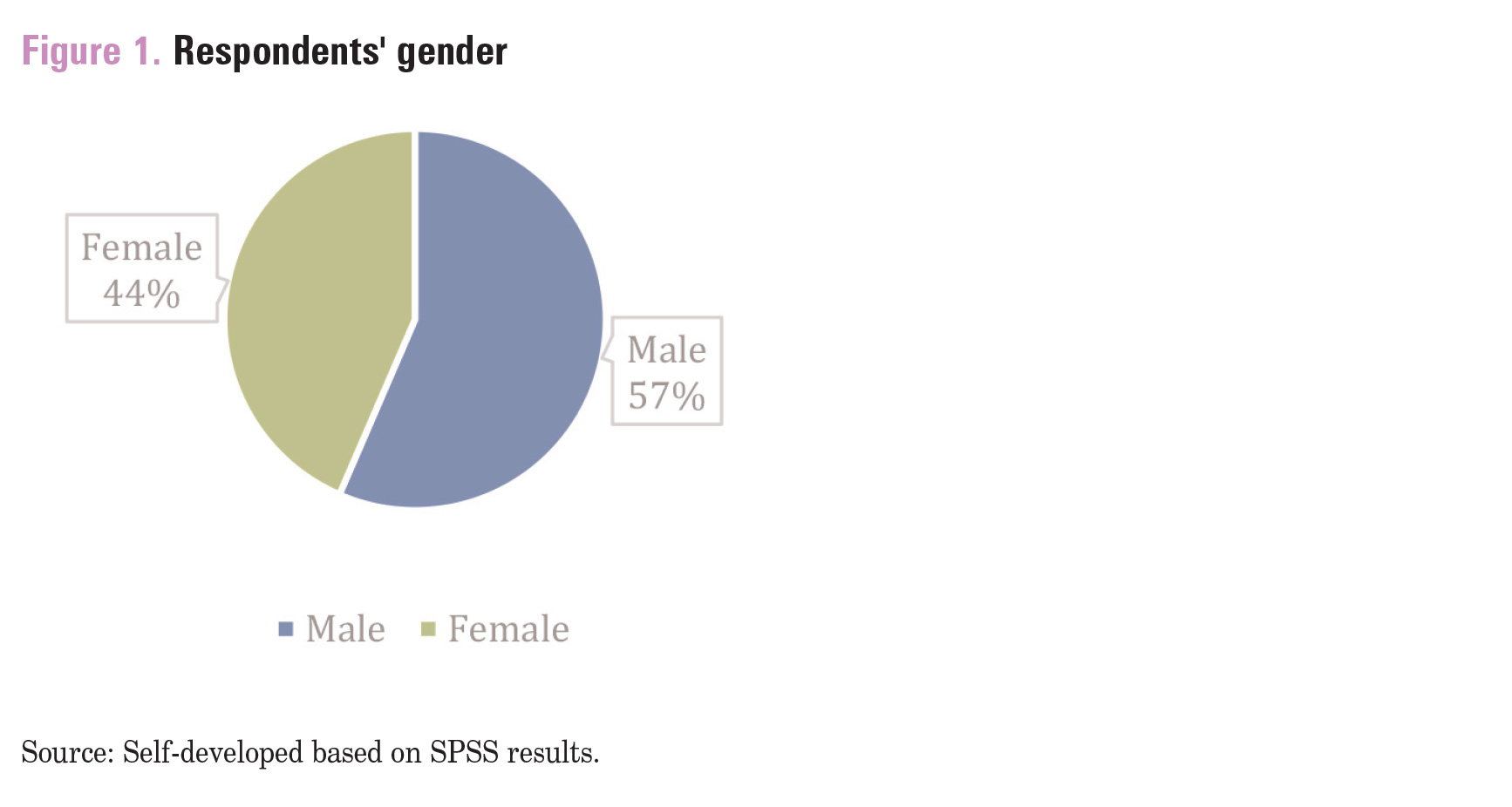
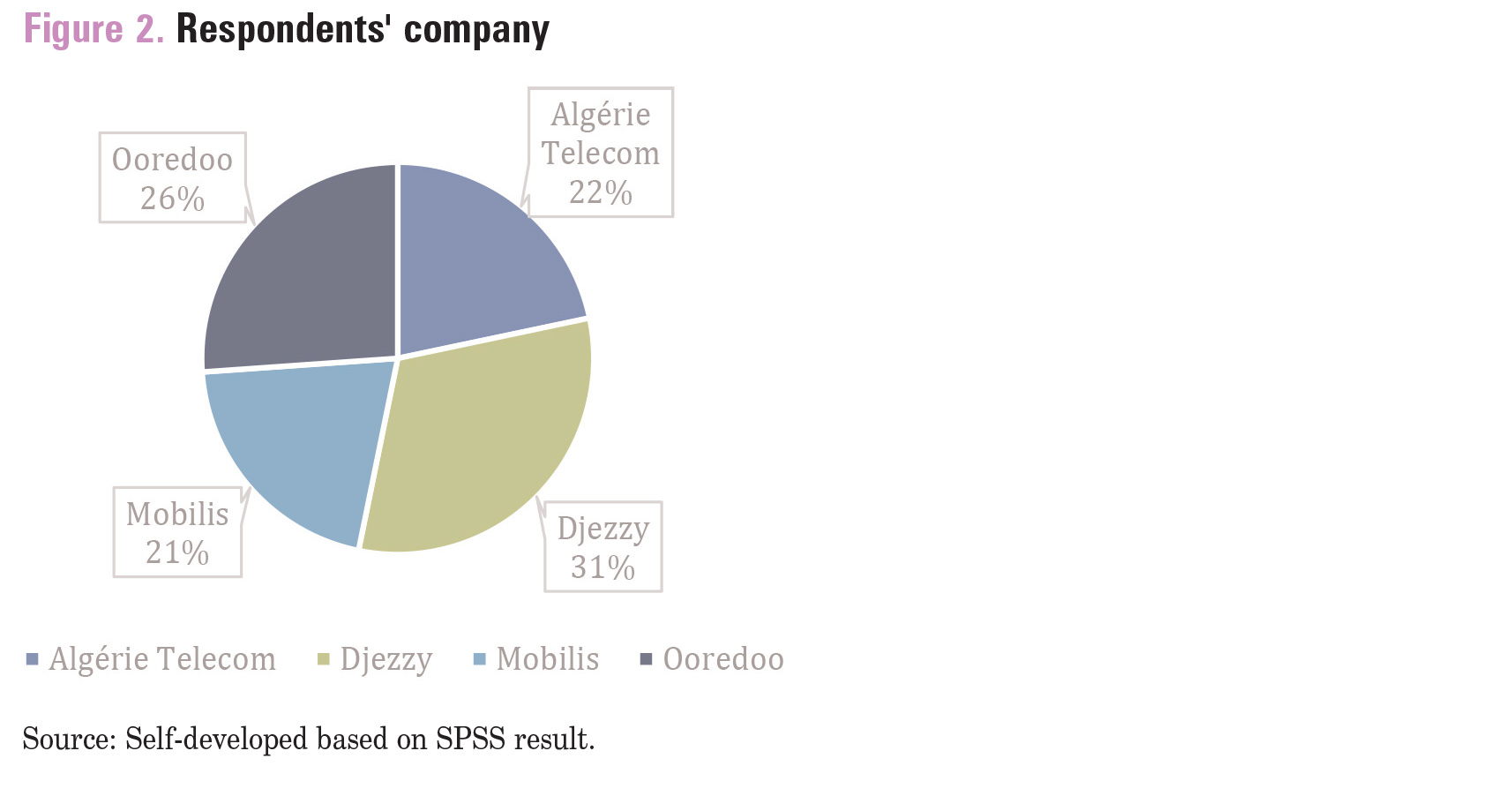
According to Figure 3’s descriptive analysis, the majority of respondents (36%) have been in their current jobs for more than 5 years, which suggests some degree of stability in Algeria’s telecommunications industry. A sizable component of the sample (35%) belongs to respondents who have worked for between 3 years and 5 years, whereas just 15% of respondents have worked for between 1 year and 3 years. Less than 1 year of employment was reported by only 14% of respondents.
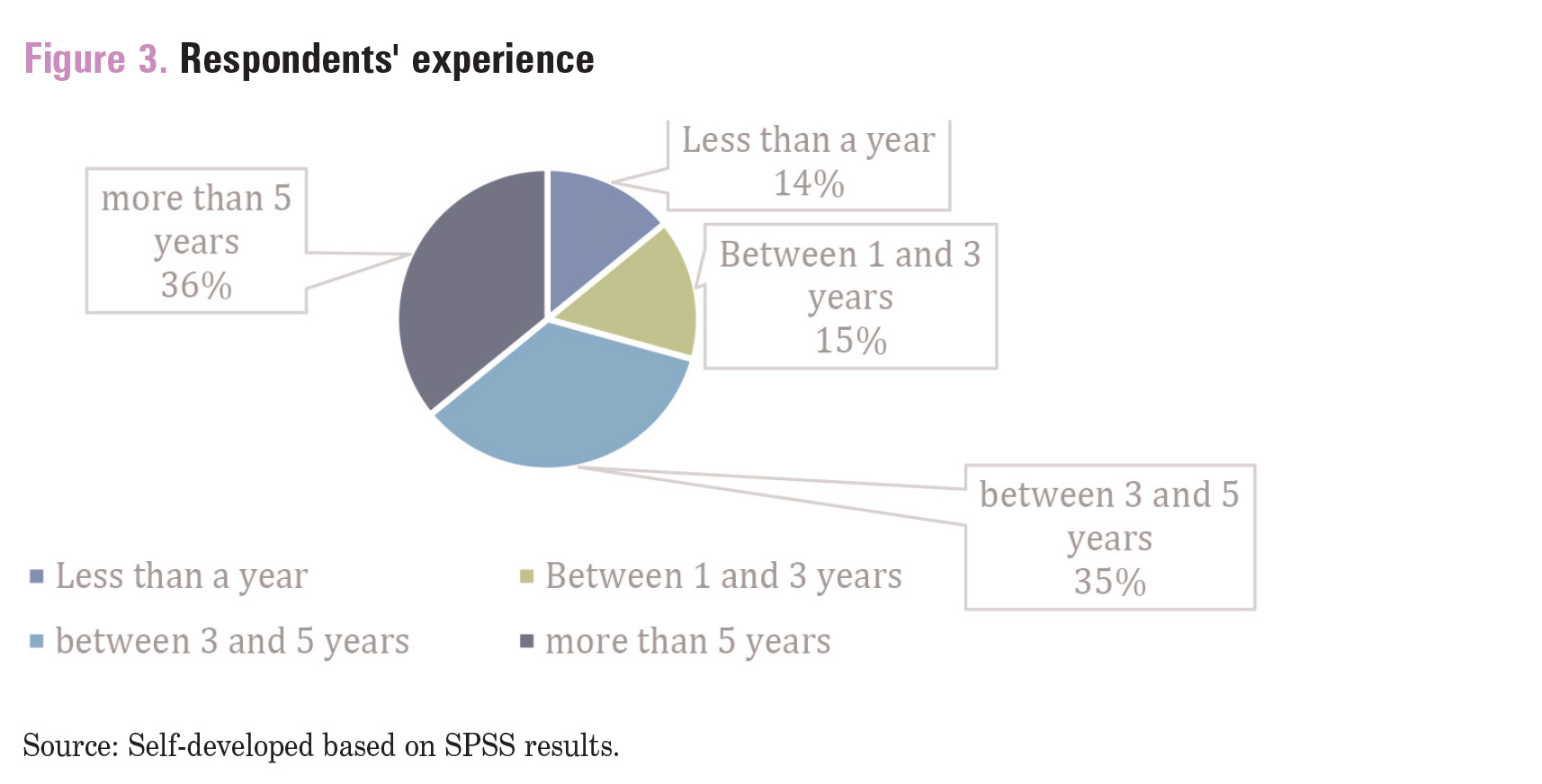
Univariate descriptive analysis
EI
The findings from four tests measuring self-awareness and emotion perception are shown in Table 1. On a scale from 1 to 7, where 1 denotes a lack of understanding or an absence of emotion perception and 7 denotes a high level of understanding or a strong emotion perception, each measure was assessed. The findings show that participants, on average, received ratings on each measure that ranged from 5.16 to 5.41 out of 7. This shows that individuals are generally capable of recognising and interpreting their own emotions as well as the emotions of others.

Table 2’s findings reveal that participants’ scores for each measure were generally high, with means ranging from 4.98 to 5.30 out of 7. This shows that individuals as a whole have some capacity for perceiving and comprehending the emotions of others.

The outcomes of the tests connected to the self-control component are shown in Table 3. With means ranging from 5.04 to 5.40, the participants’ average scores for each metric are all relatively high. In contrast, Table 4’s results, which show the results for each emotion regulation test, show scores that are quite moderate, with means that range from 4.51 to 5.02.
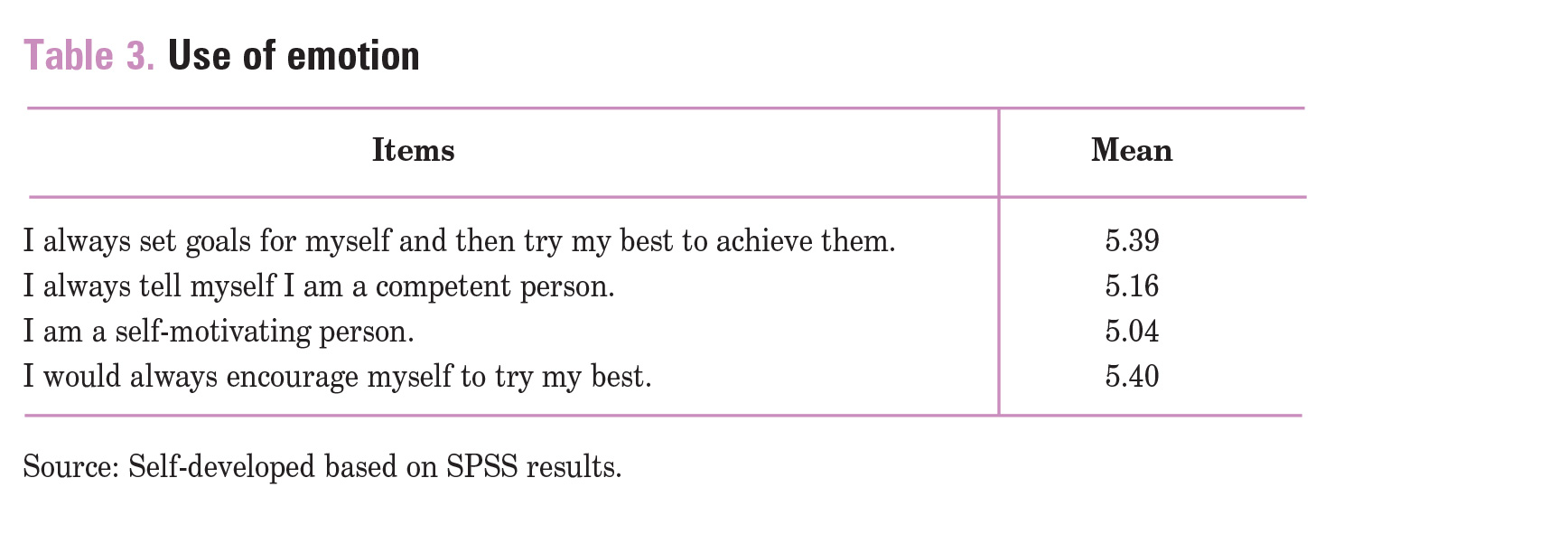
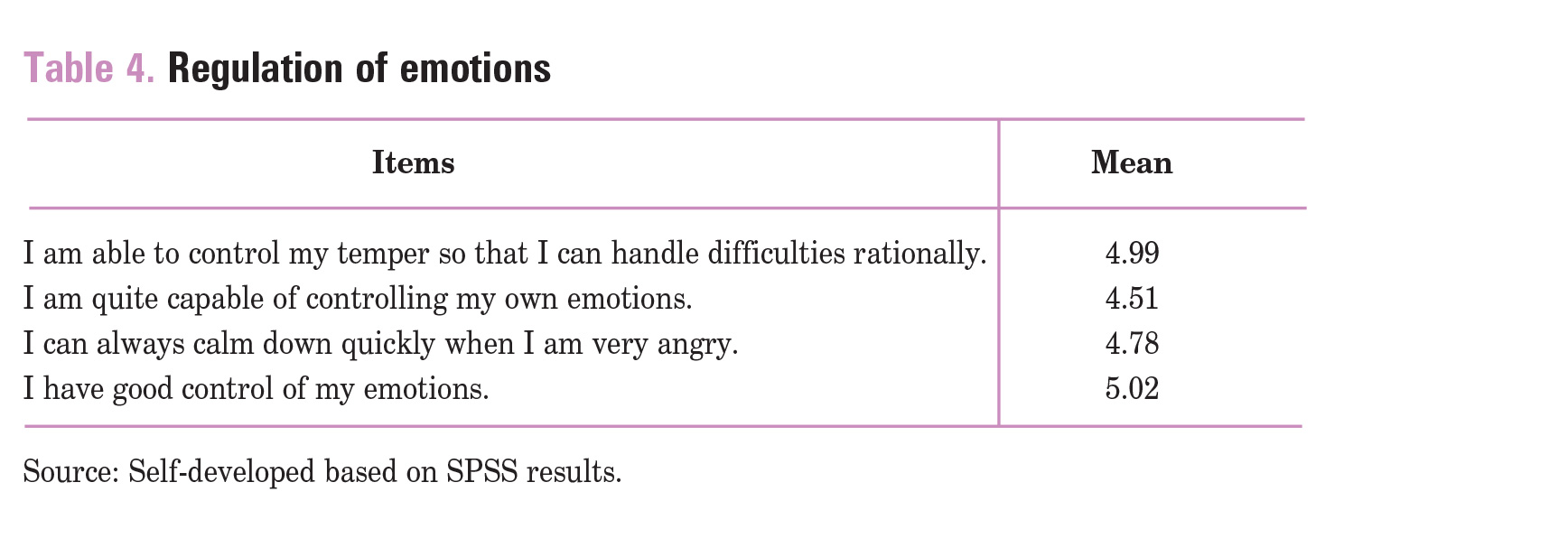
Marketing effectiveness
The evaluation’s findings show that marketing professionals have a fair understanding of both the necessity of planning the company with a comprehensive view of the marketing system (mean = 4.62, standard deviation = 1.966) and the significance of designing the company to satisfy the needs and desires of selected markets (mean = 4.78, standard deviation = 2.348).
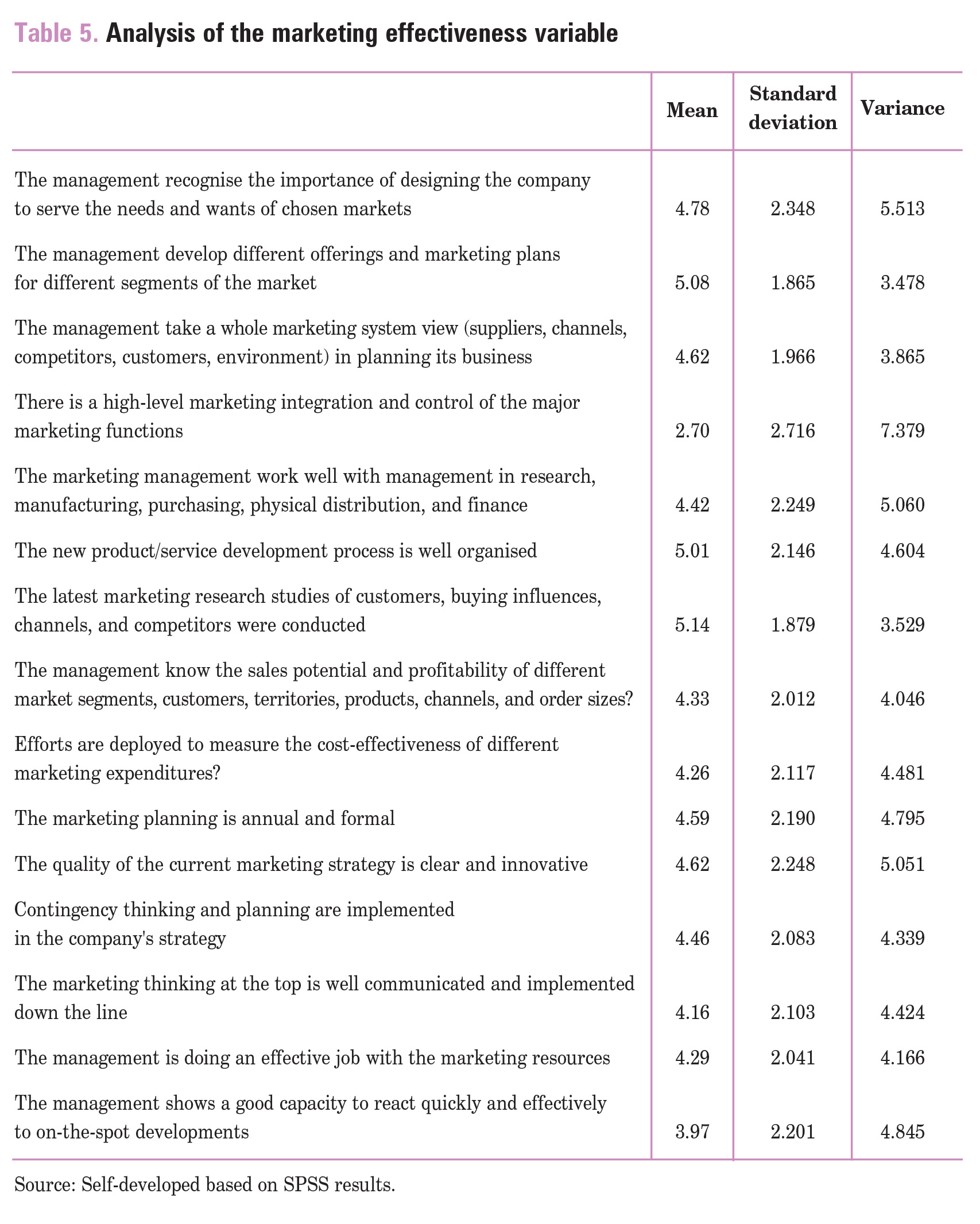
They do, however, have a better awareness of both the effectiveness of the existing marketing strategy (mean = 4.62, standard deviation = 2.248) and the significance of creating various marketing offerings and plans for various market segments (mean = 5.08, standard deviation = 1.865). The findings also suggest that marketing professionals collaborate successfully with other corporate divisions such as research, manufacturing, purchasing, physical distribution, and finance (mean = 4.42, standard deviation = 2.249) and that they have a well-structured process for developing new goods and services (mean = 5.01, standard deviation = 2.146).
There was, meanwhile, potential for improvement in several areas. For instance, marketing experts require stronger marketing integration and control at the corporate level (mean = 2.70, standard deviation = 2.716) as well as an improved ability to respond swiftly and effectively to changes on the ground (mean = 3.97, standard deviation = 2.201).
Nevertheless, the results as a whole show that marketing professionals are able to measure the profitability of various marketing expenses (mean = 4.26, standard deviation = 2.117) and plan marketing on an annual and formal basis (mean = 4.59, standard deviation = 2.190), indicating that they have a good understanding of the company’s marketing strategy and are able to implement it in a creative and understandable way.
Preliminary examinations and treatments
Initial analyses of the data were performed as part of the study to look for any missing, inflated, or outlier results. Due to Google Forms’ mandate, all survey questions were answered. Normality tests were used to look at the distribution of the data, and they showed that there wasn’t a strict normal distribution but rather a quasi-normal distribution.
Variables were decreased using the averaging method to streamline the data representation. The questionnaire consistently and accurately tested EI, according to a reliability test using Cronbach’s alpha coefficient, which also revealed good internal consistency.
Hypothesis testing
Self-emotions appraisal and marketing effectiveness
The findings of a linear regression study looking at the connection between self-perception and marketing effectiveness are shown in Table 6. The two variables have a moderate association, as indicated by the correlation coefficient (R) of 0.431 between them. We discover that the variance in self-perception can account for 18.5% of the variation in marketing effectiveness (R2 = 0.185, = 0.405, Sig = 0.000) using the coefficient of determination (R2). H1 is therefore validated.

4 Others – Emotion Appraisal and marketing effectiveness
According to Table 7’s findings, social awareness and marketing effectiveness are significantly and favourably correlated, with social awareness accounting for 19.1% of the variance in marketing effectiveness (R2 = 0.191, = 0.437, Sig = 0.000). H2 is therefore validated.

Use of emotions and marketing effectiveness
A significant and positive association between emotion use and marketing effectiveness can be inferred from Table 8’s findings, with emotion utilisation accounting for 24.2% of the variance in marketing effectiveness (R2 = 0.242, = 0.492, Sig = 0.000). H3 has thus been validated.

Regulation of emotions and marketing effectiveness
A comparison of the factors influencing marketing effectiveness and emotion control is shown in Table 9. With a correlation coefficient (R) of 0.418 and a coefficient of determination (R2) of 0.174, the findings show a substantial positive association between these two variables, indicating that emotion control positively influences marketing effectiveness. The importance of this link is further supported by the F-statistic of 19.001 and the level of significance (Sig) less than 0.05. H4 is therefore validated.

Discussion
The objective of our study is to determine how each aspect of EIperception, understanding, management, and use of emotions-affects marketing efficiency in the telecom sector. Through this research, we hope to draw attention to the importance of EI as a crucial ability for marketing professionals and its potential to improve marketing outcomes.
The main conclusions of our study show that the four dimensions of EI have a favourable and significant influence on the effectiveness of marketing initiatives carried out by experts in the telecom industry. The efficacy of a marketing approach is positively and significantly influenced by self-perception, social awareness, self-control, and emotion management, according to our observations. These findings highlight the importance of EI competency for marketers because it is linked to a significant increase in marketing effectiveness.
So, by assessing the distinct effects of each EI dimension, our research contributes to a thorough analysis of the relationship between EI and marketing effectiveness in this particular setting. In this section, we’ll evaluate our study’s key findings, consider their ramifications, and discuss how they stack up against the results of earlier research.
The findings of this study highlight the important role that different EI components have in marketing effectiveness. The study specifically shows that self-perception, social awareness, emotional usage, and management are crucial elements impacting marketing efficacy.
With a correlation coefficient of 0.431, the findings show a moderate association between self-perception and marketing performance. Additionally, the study discovered that variations in self-perception can explain 18.5% of the variance in marketing effectiveness, indicating a substantial link between these two variables (R2 = 0.185, = 0.405, Sig = 0.000).
As with social awareness, the study demonstrates a significant and favourable association between marketing effectiveness and social perception, with social perception accounting for 19.1% of the variance in marketing effectiveness (R2 = 0.191, = 0.437, Sig = 0.000).
The findings also demonstrate the importance of emotional usage and regulation, with emotional regulation accounting for 24.2% of the variance in marketing effectiveness (R2 = 0.242, = 0.492, Sig = 0.000). With a correlation coefficient of 0.418 and a coefficient of determination (R2) of 0.174 (F-statistic = 19.001, Sig = 0.000), it has been determined that emotional control significantly affects marketing effectiveness.
These results are consistent with a number of other studies in the literature demonstrating the important role played by EI aspects (Anees et al., 2020). Halim’s research (2021) offers strong support for the close relationship between EI traits and marketing success. With a significance level of 0.01, definite relationships between self-awareness, selfmanagement, and all marketing performance variables were found. The findings show a significant relationship between self-awareness and selfmanagement and marketing performance.
Additionally, the findings of Balamohan et al.’s study (2015) show a strong and favourable association. From the standpoint of the supplier, it is undeniably proven that a buyer’s capacity for building connections with suppliers, their degree of self-management, and their social awareness all have a significant bearing on their financial performance. The strong impact of EI on marketing success within a large B2B firm working in the media industry was also emphasised by a study by Ogilvie (2017).
However, it is crucial to highlight that several research investigations have produced conflicting results, casting doubt on the existence of a meaningful association between the effectiveness of marketing and EI. For instance, Kadic-Maglajlic et al.’s research (2016), as well as Lyne’s (2019), suggests that EI has little to no impact on the efficiency of marketing.
The relatively small sample size of these research, including Lyne’s study (2019) that was characterised by only 28 participants, could be a logical explanation for the findings. It is conceivable that a greater sample size could have produced findings that were more accurate and trustworthy.
The use of a different assessment tool, such as the Global Emotional Competence Inventory (GECO), in the evaluation of EI is an additional factor to consider. To assess the reliability of this test in identifying degrees of EI, additional research may be required.
The key findings of our study, in summary, emphasise the positive and considerable influence of the four dimensions of EI on the efficacy of marketing initiatives carried out by experts in the telecom industry. These findings highlight the importance of EI for marketers because it is linked to a significant increase in marketing effectiveness. For telecom companies looking to improve the efficiency of their marketing teams, the findings of this study have significant consequences. Companies can improve the quality of their marketing tactics, which will increase revenue, by creating training and development programs that are centred on enhancing EI skills. These findings also have wider ramifications for the scientific community because they show how crucial EI is in the context of marketing, which encourages more study in this area.
Therefore, to further understand this complex link, future research could examine larger samples and make use of established assessment methodologies. Overall, our research demonstrates the crucial role that EI plays in the marketing industry, offering useful information for practitioners to tweak their tactics. To better understand EI’s impact on marketing outcomes, more research should focus on other interacting aspects and variables. Researchers can continue to progress knowledge and make significant contributions to both academic and professional life by deepening their grasp of the function of EI in the marketing field.
Conclusion
The present study aimed to determine how certain aspects of EIspecifically, perception, comprehension, management, and use of emotionsaffect the success of marketing initiatives. This study contributes to a deeper knowledge of how emotions might affect the overall success of marketing outcomes by a detailed analysis of EI and its link with marketing effectiveness. The findings emphasise the value of EI in crafting persuading marketing messages, building solid relationships between brands and consumers, and inspiring great consumer experiences.
Marketing professionals can improve their campaigns and maximise client engagement by looking at the EI components in connection to the effectiveness of marketing strategies. Marketers can improve their effectiveness and establish stronger resonance with their target audience by cultivating a keen perception of consumer emotions, understanding their needs and desires, skilfully managing emotions in marketing efforts, and harnessing emotions to develop impactful strategies.
Overall, this study emphasises how important EI is as a key component of the effectiveness of marketing efforts. By incorporating EI principles into marketing strategies, businesses may build more meaningful and long-lasting relationships with consumers, which boosts brand loyalty and customer happiness and, in turn, improves business results.
Study’s limits and future research directions
There are several restrictions on the study that need to be acknowledged. The use of self-reported tests to evaluate EI has a restriction. Using self-assessment tools exclusively can lead to response biases and possible mistakes because people have a tendency to either overestimate or underestimate their own EI.
Future study should consider using performance-based measures or observer assessments to gain a more objective assessment of EI in order to lessen this constraint.
The study’s relatively small sample size is another drawback. The findings’ generalizability may be constrained by particular participant characteristics and circumstances.
A more thorough knowledge of the impact of EI characteristics on marketing effectiveness might be obtained by repeating the study with a bigger and more varied sample, including participants from various sectors or industries.
Additionally, the study ignored other potential elements that can enhance marketing performance in favour of concentrating on the impact of EI dimensions on marketing techniques.
To develop a more nuanced understanding of the complex dynamics involved in effective marketing techniques, future research might investigate the connection between EI and other variables, such as cultural influences, demographic features, or personality variances.
Last but not least, the study used self-reported data, which is susceptible to frequent technique biases. The validity and reliability of the findings would be improved by the inclusion of numerous data sources, such as the incorporation of objective performance measurements or consumer feedback.
References
1. Anees, R. T., Raju, V., Cavaliere, L. P. L., Heidler, P., & Nordin, N. A. (2020). The effect of emotional intelligence and market orientation on sales performance: The moderating role of entrepreneurial orientation. Palarch’s Journal of Archaeology of Egypt/Egyptology, 17(7), 6377–6397.
2. Babaei, V. P., Zanjirchi, S. M., & Bani, M. N. (2017). Emotional intelligence and marketing effectiveness. International Journal of Information, Business and Management, 9(4), 167.
3. Balamohan, P., Tech, M., & Gomathi, S. (2015). Emotional intelligence-its importance and relationship with individual peformance, team-effectiveness, leadership and marketing effectiveness. Mediterranean Journal of Social Sciences, 6(1), 120.
https://doi.org/10.5901/mjss.2015.v6n1p120.
4. Bansal, J., Rana, S., & Jain, E. (2022). Impact of emotional intelligence on job performance: A study of sales executives. Vivekananda Journal of Research 9, 145–157.
5. Bhalerao, H., & Sharma, K. (2017). The impact of emotional intelligence on customer satisfaction and repeat buying behavior among young consumers: An assessment of the moderating role of dental health consciousness. South Asian Journal of Management, 24(4), 88–108.
6. Billing, P. (2012). A study of emotional intelligence, thinking styles, and selling effectiveness of pharmaceutical sales representatives. University of Pennsylvania.
7. Dhani, P., & Sharma, T. (2016). Emotional intelligence; history, models and measures. International journal of science technology and management, 5(7), 189–201.
8. Halim, E. W. A. (2021). The relationship between emotional intelligence and marketing effectiveness and its impact on market spread (loyalty, product positioning and mental image) for multinational companies. Arab Journal of Administration : 41(1), Article 16.
9. Huang, M. H., & Rust, R. T. (2018). Artificial intelligence in service. Journal of Service Research, 21(2), 155–172. https://doi.org/10.1177/1094670517752459.
10. Hussain, M. S. S. (2021). Impact of emotional intelligence on the career performance of managers: An applied study of principals in Shendi municipality of Sudan. Global Journal of Economics and Business, 10(2), 426–435. https://doi.org/10.31559/ GJEB2021.10.2.12
11. Kadic-Maglajlic, S., Vida, I., Obadia, C., & Plank, R. (2016). Clarifying the influence of emotional intelligence on salesperson performance. Journal of Business & Industrial Marketing, 31(7), 877–888. https://doi.org/10.1108/JBIM-09-2015-0168
12. Kanesan, P., & Fauzan, N. (2019). Models of emotional intelligence: A review. E-Bangi, 16, 1–9.
13. Kayabasi, A., & Mtetwa, T. (2016). Impact of marketing effectiveness and capabilities, and export market orientation on export performance: Evidence from Turkey. European Business Review, 28(5), 532–559.
14. Khraim, H. (2023). The impact of emotional intelligence on job performance at private hospitals: The moderating role of organizational culture. Problems and Perspectives in Management, 21(1), 459–470. https://doi.org/10.21511/Ppm.21(1)0.2023.39.
15. Kotler, P. (1977). From sales obsession to marketing effectiveness. Harvard Business Review, 55(6), 67–75.
16. Kotler, P., & Keller, K. L. (2016). Marketing Management (14th edition). Shanghai: Shanghai People’s Publishing House.
17. Lavraè, Janja & Meško, Maja & Jereb, Eva. (2023). Artificial Intelligence and Career Development. 543–553. 10.18690/um.fov.3.2023.42.
18. Lyne, J. (2019). The impact of emotional intelligence on business-to-business software as a service sales performance [Doctoral Dissertation, Dublin, National College of Ireland]. https://norma.ncirl.ie/id/eprint/4008
19. Meshkat, M., & Nejati, R. (2017). Does emotional intelligence depend on gender? A study on undergraduate English majors of three Iranian Universities. Sage Open, 7(3), 2158244017725796. https://doi.org/10.1177/2158244017725796
20. Nwokah, N. G., & Ahiauzu, A. I. (2009). Emotional intelligence and marketing effectiveness. Marketing Intelligence & Planning, 27(7), 864–881. https://doi.org/ 10.1108/02634500911000199
21. Ogilvie, J., Rapp, A., Agnihotri, R., & Bachrach, D. G. (2017). Translating sales effort into service performance: It’s an emotional ride. Journal of Personal Selling & Sales Management, 37(2), 100–112. https://doi.org/10.1080/08853134.2017.1287577
22. Pegah, H. (2020). The relationship between salesmen’s emotional intelligence and sales skills in in-person sales (Case study: Salesmen of commercial complexes in the third municipality district of Bandar Abbas city). International Journal of Marketing Studies, 12(2), 62–71. https://doi.org/10.5539/ijms.v12n2p62
23. Pradeep, K. C. (2022). Emotional intelligence and organisational performance in Nepalese commercial banks. Marsyangdi Journal, 3(1), 128–135. https://doi.org/ 10.3126/mj.v3i1.47962
24. Schlegel, K., & Mortillaro, M. (2019). The Geneva emotional competence test (GECO): An ability measure of workplace emotional intelligence. Journal of Applied Psychology, 104(4), 559–580. doi: 10.1037/apl0000365.
25. Singh, A., Prabhakar, R., & Kiran, J. S. (2022). Emotional intelligence: A literature review of its Concept, models, and measures. Journal of Positive School Psychology, 6(10), 2254–2275.
26. Supramaniam, S., & Singaravelloo, K. (2021). Impact of emotional intelligence on organisational performance: An analysis in the Malaysian public administration. Administrative Sciences, 11(3), 76. https://doi.org/10.3390/admsci11030076
27. Vredeveld, Anna. (2018). Emotional intelligence, external emotional connections and brand attachment. Journal of Product & Brand Management. 27. 10.1108/JPBM-102017-1613.
28. Wang, L. (2020). Artificial intelligence and career development of college teachers: Challenge and countermeasures. In Journal of Physics: Conference Series, 1550(2), 022030. https://doi.org/10.1088/1742-6596/1550/2/022030.
29. Webster, C. (1995), „Marketing culture and marketing effectiveness in service firms”, Journal of Services Marketing, Vol. 9 No. 2, pp. 6–21. https://doi.org/10.1108/08876049510085973
30. Wong, C. S., & Law, K. S. (2002). Wong and law emotional intelligence scale (Wleis) [Database Record]. APA Psyc Tests.
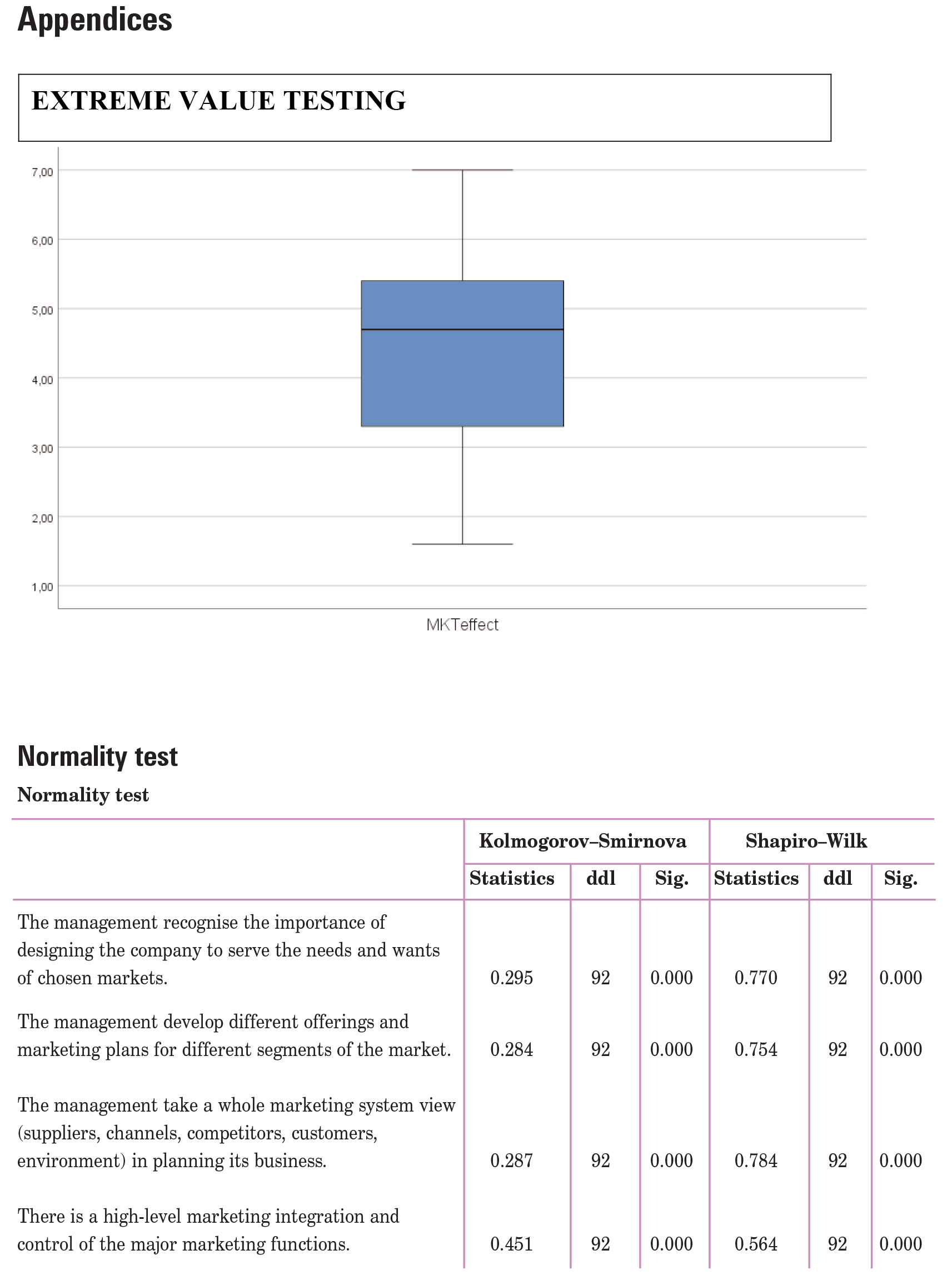
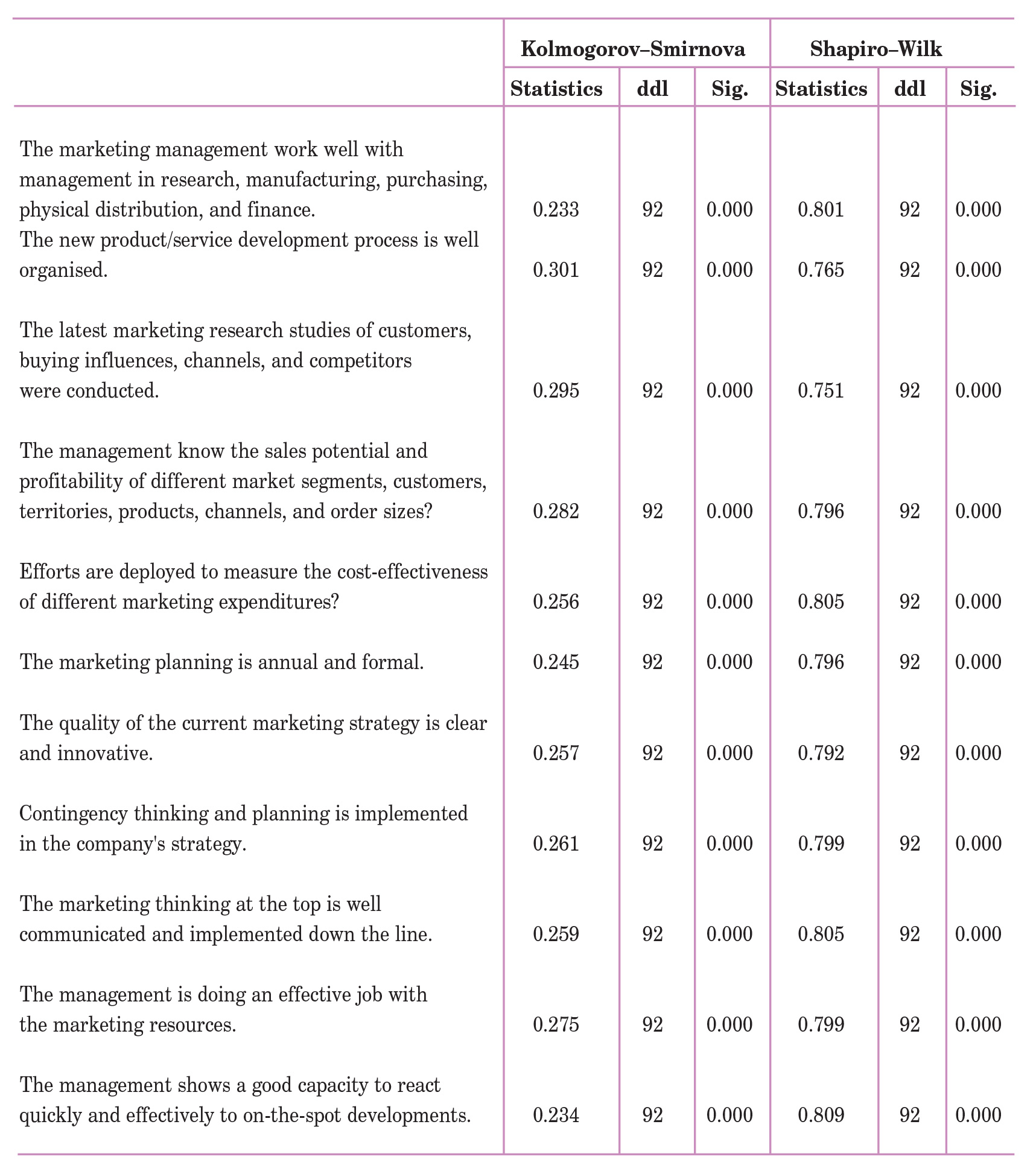

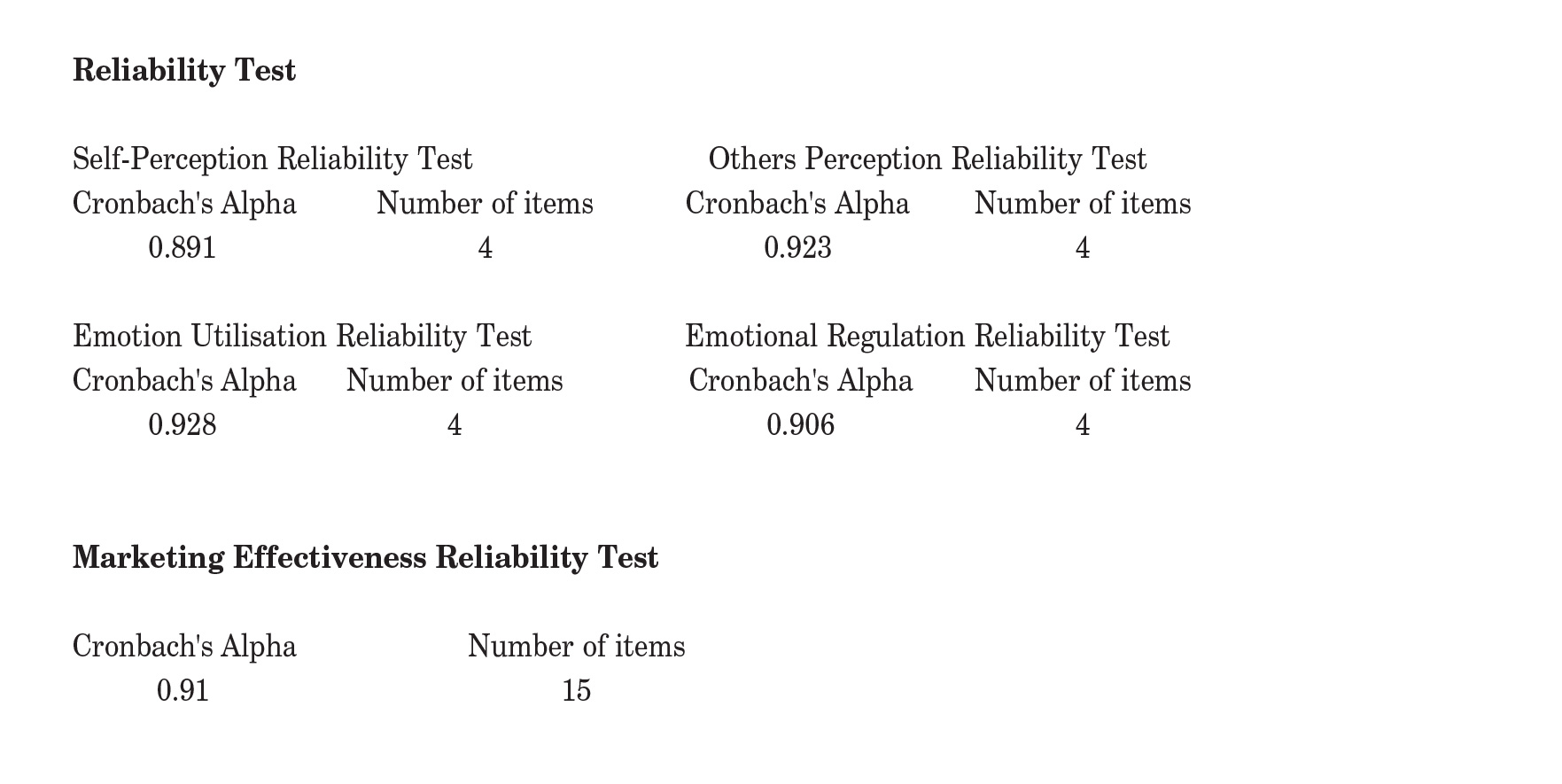
Liza Mousli — an independent researcher and recent graduate in marketing management from the Higher School of Management, is genuinely passionate about the world of marketing and its connections with psychology. She’s eager to bring her academic background into practical use and contribute to the marketing field.
Mehdi Bouchetara — is an assistant-professor in management sciences at the National Higher School of Management in Algeria. He is also pursuing another doctoral thesis at the University of Lille, focusing on the theme of financial inclusion. His research themes include monetary and financial economics, as well as banking risk management. Currently, I am specifically working on the regulation and governance of banks, particularly in Algeria and the MENA region. I am also interested in the ecosystem and financing of startups in Algeria.
Chafika Larras — is an assitant-professor and researcher at the National Higher School of Management (ENSM) in Tipaza, Algeria. She is in charge of the Master’s program in HR management at ENSM and heads the strategic digitization office at the same school. Her research areas include knowledge management, change management, human resource management, and organizational behavior. She is a member of editorial committees of academic journals, has published articles, and has participated in several national and international conferences. She is also the author of a course material on human resource management. Beyond her research activities, she holds key roles in the educational process within ENSM and has been involved in organizing various academic events.
Sabrina Iraten — is an assistant-professor at the National Higher School of Management (ENSM). She regularly contributes to modules on supply chain management, marketing, and logistics distribution. She has published academic articles in national and international scientific journals within her main research areas: supply chain management and marketing. She is a member of the research teams at the Management, Performance, and Innovation Laboratory, EHEC Alger, and the LIMGE Laboratory, ENSM.

